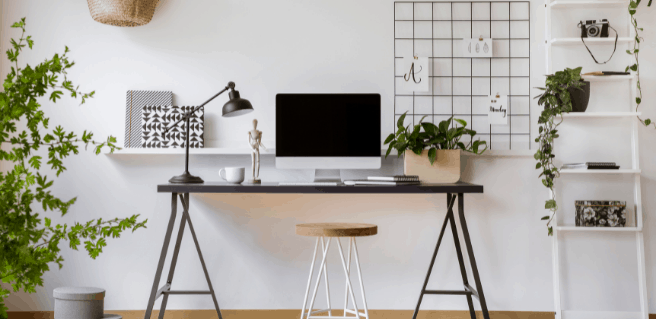Home design trends changed in 2020 when the world halted in the face of the COVID-19 pandemic. To remain safe, working and learning from home became the new normal. And many people struggled in their home environment as they tried to morph it into a space for both work and relaxation.
With an unprecedented pandemic causing harmful effects on physical and mental health, there was a sudden need for homes to offer a comforting and stimulating atmosphere.
What did this mean for home design trends?
Home Offices Are Now a Focal Point
As people moved their offices home to work safely and remotely, challenges arose as there were no established spaces to work. Work and home life blended. Living rooms, bedrooms and kitchens became home offices. As the pandemic progressed and the chances of returning to the office became more unlikely, office space within the home became a priority.
Homeowners carved out spaces in their homes solely dedicated to their work lives. This included finding aesthetically pleasing backgrounds for the never-ending Zoom calls, filling their space with plants to offer natural decor and adding functional furniture with plenty of storage to optimize this new space.
Goodbye Open Floor Plans, Hello Privacy
Recent years in the architecture community saw a rise in the demand for open floor plans. The trend became popular when homeowners with smaller floor plans needed to optimize their space, giving it multiple uses and an illusion that the space is larger and more open.
With work life and home life combining, days blended. During the pandemic, spaces no longer held just one or two purposes but began to serve multiple necessary functions. The need to carve out smaller and more specific spaces became a must, and soon, homes were imitating architecture trends not seen in decades. The door is back! It is essential for those in need of a private space for work or a separate area for students during the school day.
The Great Migration Outside
With people following stay-at-home restrictions to ensure health and safety, homes became a drab place. Once a place of refuge, homes were now a place to escape.
People began to improve their outdoor spaces – discovering a love for gardening, putting in a pool or gazebo, adding potential outdoor office spaces and more. The need for finished outdoor spaces trended with shelter-in-place regulations as families looked for places beyond the four walls of the home to spend time. Then as regulations began to lift, making it safe to remain socially distanced while socializing outdoors took precedent.
Invigorating or Calming?
The rise in the pandemic also brought a surge in new color palette choices for homeowners. Looking to insert a feeling of coziness, homeowners start to favor beiges, creams and whites. Dulux announced their color of the year for 2021 following the first year of the pandemic to be Brave Ground, with Sherwin Williams following closely by announcing Urbane Bronze. Both followed the trend to keep our home spaces cool, calm and collected.
On the other end of the spectrum, people looked to make their homes more stimulating, favoring bolder choices. Pantone announced their color of the year for 2021 to be an Illuminating yellow and Ultimate Gray, encouraging consumers to choose a pop of color alongside a muted tone.
Prioritizing Function Over Beauty
Recent years have seen an increase in aesthetically pleasing homes. Social media encouraged homeowners to find their niche décor style and run with it. Spaces are decorated in ways that directly reflect personal style.
While this provided a great way to be expressive, it became impractical with furniture pieces prioritizing beauty over function or comfort. With so much time spent in the same space, there was a real need for comfortable furniture with multiple uses and ample storage.
Prioritization for functional pieces rather than aesthetic furniture began to trend as kitchens were also classrooms and living rooms became daycares. Students needed their bedrooms to act as personal spaces, as well as their place to learn.
This past year brought changes to our daily lives that directly affected our living spaces. Most of our lives were conducted within the walls of our homes, causing the decline of previously fashionable architectural and design styles and the emergence of new home trends. Gone were the open floor plans and empty spaces in favor of more functional and inviting spaces. The pandemic changed how we view and design our homes, turning our homes into a place to live, work and learn.
Find more on home trends by clicking here.
